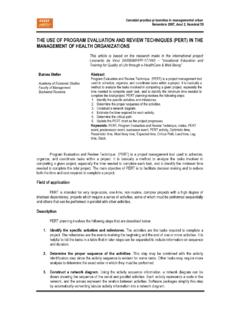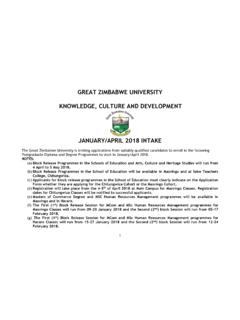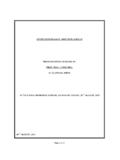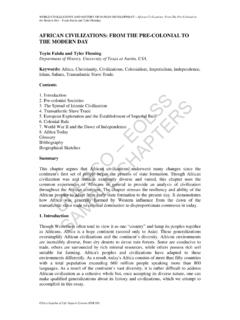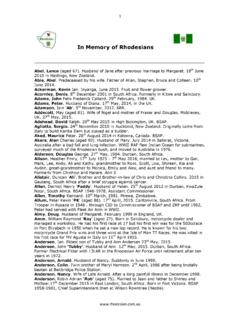Transcription of URBAN DEVELOPMENT IN ZIMBABWE: A HUMAN …
1 120 Munzwa K. M. and Wellington J. URBAN DEVELOPMENT IN zimbabwe : A HUMAN settlement perspective Theoretical and Empirical Researches in URBAN Management Number 5(14) / February 2010 URBAN DEVELOPMENT IN zimbabwe : A HUMAN settlement perspective Killian MUNZWA Department of Rural and URBAN Planning, University of zimbabwe POB MP 167, Mount Pleasant, Harare, zimbabwe Jonga WELLINGTON Ethiopian Civil Service College POB 5648, CMC Road, Addis Ababa, Ethiopia Abstract This paper examines and analyses the historical DEVELOPMENT of Zimbabwean towns and cities with a view to tracing and understanding policy directions, URBAN spatial DEVELOPMENT trends and other factors such as population dynamics that may have led to the DEVELOPMENT of the present-day URBAN settlements in the country.
2 The paper observes that whilst pre-colonial cities existed during the golden age of the Munhumutapa dynasty and empire, these had no influence on the modern town and city because they were too distant and their experiences had long been lost by the time the colonial town was introduced in the country, some four centuries later. Furthermore the paper observes that whilst policy may easily be changed or even reversed, it is a near impossibility to do the same with the spatial physical developments such as buildings and infrastructure roads, water reticulation, sewerage reticulation and treatment works, railway lines, telecommunication lines and power lines.
3 As a result of these realities the form and structure of our cities has remained to a large extent as originally conceived, designed and developed with perhaps some cosmetic changes in the form of redevelopments and densification of certain sectors or areas and sprawling expansion. This has also led to the many challenges of URBAN poverty, inadequate housing, inadequate provision of serves (potable clean water, energy, and garbage collection) and environmental quality - issues of pollution- the towns and cities are grappling with today typified by Harare and Chitungwiza, which are sited upstream of their water supply sources and as a result pollute them.
4 The paper also notes that the socio-economic policies and political expedience by both the colonial and independent governments have had significant impacts on the morphology (shape, structure and population distribution) of towns and cities of zimbabwe Keywords: URBAN , DEVELOPMENT , HUMAN settlement , population, colonial, services, morphology, demography. 1. INTRODUCTION The history of URBAN DEVELOPMENT in zimbabwe is directly related to colonialism. Before colonisation the predominant nature of HUMAN settlements was entirely scattered and sparsely populated rural settlements with no cities and towns except the long disserted pre-colonial city states of Great zimbabwe , Khami and Dhlodhlo to mention but only the largest.
5 This is explained basically by two fundamental features of society then, that: population was still very meagre relative to today; and also, Munzwa K. and Wellington J. URBAN DEVELOPMENT IN zimbabwe : A HUMAN settlement perspective 121 Theoretical and Empirical Researches in URBAN Management Number 5(14) / February 2010 the disposition of economic activities was mainly primary based farming, very small-mining, limited trade especially in petty kind of commodities. The thrust of this paper it to trace the trends, policy directions and population dynamics that have led to the DEVELOPMENT of the present-day URBAN settlements in the country, plus the resultant impacts of the key drivers of URBAN growth and expansion, commonly referred to in literature as urbanisation.
6 The primary aim is to show that URBAN DEVELOPMENT policies once executed are very difficult to change or reverse. For instance the infrastructural DEVELOPMENT decisions, of say the direction of growth, sewerage reticulation and disposal and the siting of major land uses are usually made very early, in the DEVELOPMENT of given settlements. The paper begins by showing the chronological aspects of the history of HUMAN settlements in zimbabwe and then highlights the major landmarks in the DEVELOPMENT , making an analysis of the different policies shaping the URBAN terrain in the country. After that, emerging issues in Zimbabwean urbanisation process are explored leading to a logical conclusion of the many challenges URBAN planners, developers, and managers have to grapple with today.
7 These are challenges of URBAN sprawl, URBAN poverty, inadequate housing especially for the URBAN poor, provision of inadequate infrastructure and services including clean potable water, sewerage reticulation, power supply, garbage collection and disposal, and adequate transportation, at affordable levels. Simply put the aims of this paper are: to provide a historical framework of URBAN policy trends and resultant morphology, over time; to provide an explanation to the form, structure and distribution of URBAN centres in zimbabwe ; to provide a framework of understanding the basis of the URBAN challenges faced today; and to draw lessons and conclusions.
8 The methodology followed by the researchers included reviews of documents such as policies, plans, councils administrative reports, books and other similar secondary data sources. Interviews were conducted with expert personnel in the Ministry of Local Government, Public Works and National Housing and also those in the selected URBAN councils. The authors also drew from their many years experience in spatial planning and DEVELOPMENT and local government administration. 2. AN OVERVIEW OF URBAN SETTLEMENTS IN zimbabwe Like in most Sub-Saharan countries one cannot discuss urbanisation without making reference to colonisation and its impacts.
9 Colonisation brought with it a new socio-political and economic 122 Munzwa K. M. and Wellington J. URBAN DEVELOPMENT IN zimbabwe : A HUMAN settlement perspective Theoretical and Empirical Researches in URBAN Management Number 5(14) / February 2010 dispensation. The mission of the settler was to take occupation of the land and make it his home, by exploiting all the available resources to best advantage. In trying to achieve this they created an administration system that was foreign to the indigenous people, but naturally supportive of this aim. They set up administrative structures and centres and developed supportive infrastructure such as URBAN centres, and communication linkages in the form of railway lines, roads and telegram lines, (Wekwete, 1992, Zinyama et al.)
10 1993). The new administration also reorganised spatial land use by expropriating prime land from the indigenous people and forcibly moving them in to marginal areas, where the soils were not only sandy and very poor, but also received very low and unreliable rainfall. The same system of land expropriation was used for all URBAN and mining centres. This spatial re-organisation was enabled by a number of statutes, such as the land apportionment act of 1930, the land husbandry act of 1950 and the land tenure act of 1969. DEVELOPMENT in space has been taking place but with a time dimension. Three principal temporal milestones are noted in the history of urbanisation of zimbabwe , namely, the pre-colonial era, the colonial era and the post-independence period.

